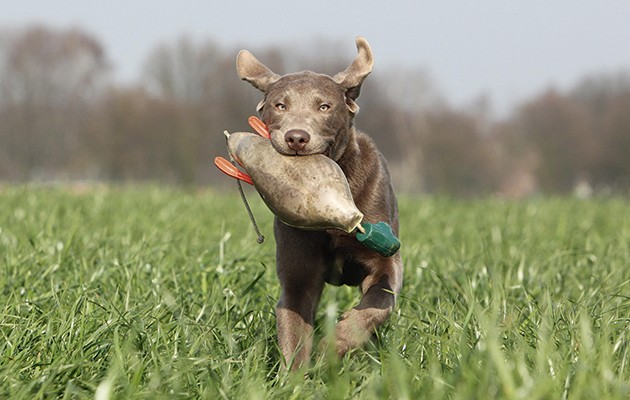Silver labradors and sable spaniels might look attractive but they’ll cause the Kennel Club to see red. David Tomlinson suggests that beauty is still best in the eye of the beholder
It’s long been argued that a good horse can’t be a bad colour, and I reckon that’s generally true with gundogs, too. However, most of us have preferences, so when it comes to choosing the colour of our next puppy we have generally made up our minds before going to view a litter.
THE DIFFERENT COLOURS OF GUNDOGS

With labradors there are a lot of people with Henry Ford sympathies: any colour, so long as it’s black. Black is the original labrador colour, though the first registered yellow labrador was a dog called Ben of Hyde, bred by Major C J Radclyffe in 1899. Judging by the surviving photographs of Ben, he was a dark yellow, probably close to what we now call fox red. Yellows took a while to catch on: in 1924 the Yellow Labrador Club was formed to encourage the breeding of pure yellow labrador retrievers. Today, 99 years later, the Club remains true to its original objective.
Go to any major dog show and you will see many labradors that look white rather than yellow, as many show enthusiasts believe the paler the better. The breed standard insists that the ‘only correct colours are wholly black, yellow and liver/ chocolate. Yellows range from light cream to fox red, livers/chocolates range from light to dark. Small white spot on chest and the rear of front pasterns permissible. Any other colour or combination of colours not permitted.’ The white on the rear pasterns harks back to Dual Champion Banchory Bolo (born 1915), one of the most influential dogs in the history of the breed. These white splashes are known to this day as Bolo marks.
There is a record of two liver-coloured dogs being born in the Buccleuch Kennels in 1892, but their fate is unknown. They may well have been culled, as at the time black was the only favoured coat colouring. It wasn’t until the early 1930s that liver became an accepted colour. I have never found out when the name was changed to chocolate, but it did make the brown puppies more marketable, though some purists still insist on calling them liver. Despite a lack of Kennel Club recognition, so-called silver labradors are now being bred. They resemble strange-looking Weimaraners. I’ve yet to see one in the shooting field.
One thing that you must never do is describe a labrador as golden, even if it is. However, when the golden retriever was first recognised by the Kennel Club in 1913, it was known as a yellow retriever. It wasn’t until the Golden Retriever Club was established in 1920 that the official breed name was changed. As with labradors, show enthusiasts are keen on pale dogs with the traditional russet-gold dogs tending to come from working kennels.

For nearly 40 years I owned blackand- white English springers, but liver and white has long been the most popular colour. My first springer was a tricolour, an accepted but rare colour in springers, especially in working lines. Disappointingly, no tricolours appeared in the next seven generations. In recent years predominantly white springers have become popular, particularly in trialling circles, but with the litters I bred the heavily marked puppies were most popular.
Cocker spaniels come in a greater variety of colours than any other pedigree breed recognised by the Kennel Club. First of all there are the solid colours: black, red, golden, liver (chocolate); black and tan, liver and tan. Then there are what the breed standard refers to as particolours: the bicolours (such as black and white, and lemon and white), tricolours (black, white and tan; liver, white and tan) and, lastly, roans. Any other colours, such as sable and tan, are ‘undesirable’, though they may be popular in the pet market. Black is the most popular for working cockers, but if you want a cocker for shooting there’s no reason why you shouldn’t choose a more interesting colour.
Look at the Victorian paintings of Clumbers and you will see handsome white spaniels with attractive orange or lemon markings. On the show benches predominately white dogs were most popular, so the markings faded away, while the dogs became bigger and bigger. Today there’s a welcome trend, promoted by the Working Clumber Spaniel Society, to smaller, more heavily marked dogs, though the Kennel Club’s breed standard still prefers ‘a plain white body… lemon or orange markings are permissible’. I find the smaller, more heavily marked dogs much more attractive than the traditional white show-bred dogs, which look to me like miniature polar bears.
The breed standard dictates the colour of several of the continental gundog breeds. Large Munsterlanders, for example, can only be black and white, though brown and white puppies do occur. In the past these would have been culled but today they are more likely to be given away as pets. In contrast to the Munsterlander, German shorthaired pointers come in a considerable variety of colours, ranging from liver roan to solid black. Liver roan dogs can be strikingly handsome, but the solid black dogs always remind me of cross-bred labradors. However, they have become increasingly popular in recent years, a reminder that beauty is in the eye of the beholder.




